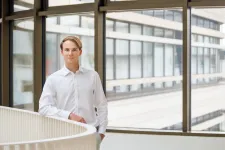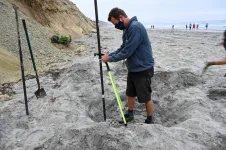(Press-News.org) Quantum computer: One of the obstacles for progress in the quest for a working quantum computer has been that the working devices that go into a quantum computer and perform the actual calculations, the qubits, have hitherto been made by universities and in small numbers. But in recent years, a pan-European collaboration, in partnership with French microelectronics leader CEA-Leti, has been exploring everyday transistors--that are present in billions in all our mobile phones--for their use as qubits. The French company Leti makes giant wafers full of devices, and, after measuring, researchers at the Niels Bohr Institute, University of Copenhagen, have found these industrially produced devices to be suitable as a qubit platform capable of moving to the second dimension, a significant step for a working quantum computer. The result is now published in Nature Communications.
Quantum dots in two dimensional array is a leap ahead
One of the key features of the devices is the two-dimensional array of quantum dot. Or more precisely, a two by two lattice of quantum dots. "What we have shown is that we can realize single electron control in every single one of these quantum dots. This is very important for the development of a qubit, because one of the possible ways of making qubits is to use the spin of a single electron. So reaching this goal of controlling the single electrons and doing it in a 2D array of quantum dots was very important for us", says Fabio Ansaloni, former PhD student, now postdoc at center for Quantum Devices, NBI.
Using electron spins has proven to be advantageous for the implementation of qubits. In fact, their "quiet" nature makes spins weakly interacting with the noisy environment, an important requirement to obtain highly performing qubits.
Extending quantum computers processors to the second dimension has been proven to be essential for a more efficient implementation of quantum error correction routines. Quantum error correction will enable future quantum computers to be fault tolerant against individual qubit failures during the computations.
The importance of industry scale production
Assistant Professor at Center for Quantum Devices, NBI, Anasua Chatterjee adds: "The original idea was to make an array of spin qubits, get down to single electrons and become able to control them and move them around. In that sense it is really great that Leti was able to deliver the samples we have used, which in turn made it possible for us to attain this result. A lot of credit goes to the pan-European project consortium, and generous funding from the EU, helping us to slowly move from the level of a single quantum dot with a single electron to having two electrons, and now moving on to the two dimensional arrays. Two dimensional arrays is a really big goal, because that's beginning to look like something you absolutely need to build a quantum computer. So Leti has been involved with a series of projects over the years, which have all contributed to this result."
The credit for getting this far belongs to many projects across Europe
The development has been gradual. In 2015, researchers in Grenoble succeeded in making the first spin qubit, but this was based on holes, not electrons. Back then, the performance of the devices made in the "hole regime" were not optimal, and the technology has advanced so that the devices now at NBI can have two dimensional arrays in the single electron regime. The progress is threefold, the researchers explain: "First, producing the devices in an industrial foundry is a necessity. The scalability of a modern, industrial process is essential as we start to make bigger arrays, for example for small quantum simulators. Second, when making a quantum computer, you need an array in two dimensions, and you need a way of connecting the external world to each qubit. If you have 4-5 connections for each qubit, you quickly end up with a unrealistic number of wires going out of the low-temperature setup. But what we have managed to show is that we can have one gate per electron, and you can read and control with the same gate. And lastly, using these tools we were able to move and swap single electrons in a controlled way around the array, a challenge in itself."
Two dimensional arrays can control errors
Controlling errors occurring in the devices is a chapter in itself. The computers we use today produce plenty of errors, but they are corrected through what is called the repetition code. In a conventional computer, you can have information in either a 0 or a 1. In order to be sure that the outcome of a calculation is correct, the computer repeats the calculation and if one transistor makes an error, it is corrected through simple majority. If the majority of the calculations performed in other transistors point to 1 and not 0, then 1 is chosen as the result. This is not possible in a quantum computer since you cannot make an exact copy of a qubit, so quantum error correction works in another way: State-of-the-art physical qubits do not have low error rate yet, but if enough of them are combined in the 2D array, they can keep each other in check, so to speak. This is another advantage of the now realized 2D array.
The next step from this milestone
The result realized at the Niels Bohr Institute shows that it is now possible to control single electrons, and perform the experiment in the absence of a magnetic field. So the next step will be to look for spins - spin signatures - in the presence of a magnetic field. This will be essential to implement single and two qubit gates between the single qubits in the array. Theory has shown that a handful of single and two qubit gates, called a complete set of quantum gates, are enough to enable universal quantum computation.
INFORMATION:
Imaging techniques enable a detailed look inside an organism. But interpreting the data is time-consuming and requires a great deal of experience. Artificial neural networks open up new possibilities: They require just seconds to interpret whole-body scans of mice and to segment and depict the organs in colors, instead of in various shades of gray. This facilitates the analysis considerably.
How big is the liver? Does it change if medication is taken? Is the kidney inflamed? Is there a tumor in the brain and did metastases already develop? ...
December 28, 2020 - Platelet-rich plasma (PRP) treatment, which involves injecting a small amount of a patient's own blood to release various growth factors from platelets, continues to increase in popularity. The American Society of Plastic Surgeons has tracked the procedure since 2015 and reports a 25 percent increase in cosmetic PRP use in the last four years.
That increase in popularity could in part trace back to celebrities extolling the procedure's cosmetic benefits. Yet with so much information coming from so many different sources about the treatment's ...
Cells, the basic unit of life, are surrounded by a limiting membrane called the plasma membrane. Inside cells, there are various membrane-bounded organelles, each of which has various and distinctive functions. How these organelles, which individually boast different functions, have been developed during evolution remains unknown. This phenomenon has fascinated many researchers.
In the study published in Nature Communications, the evolutionary relationship between two different organelles in liverwort cells has been revealed: the cell plate, which divides ...
Two new studies from the University of Rochester Medical Center (URMC) have uncovered an association between vaping and mental fog. Both adults and kids who vape were more likely to report difficulty concentrating, remembering, or making decisions than their non-vaping, non-smoking peers. It also appeared that kids were more likely to experience mental fog if they started vaping before the age of 14.
While other studies have found an association between vaping and mental impairment in animals, the URMC team is the first ...
Researchers from Yokohama National University in Japan have developed a prototype microprocessor using superconductor devices that are about 80 times more energy efficient than the state-of-the-art semiconductor devices found in the microprocessors of today's high-performance computing systems.
As today's technologies become more and more integrated in our daily lives, the need for more computational power is ever increasing. Because of this increase, the energy use of that increasing computational power is growing immensely. For example, so much energy is used by modern day data centers that some are built near rivers so that the flowing water ...
COLUMBUS, Ohio - A single positive experience on a psychedelic drug may help reduce stress, depression and anxiety symptoms in Black, Indigenous and people of color whose encounters with racism have had lasting harm, a new study suggests.
The participants in the retrospective study reported that their trauma-related symptoms linked to racist acts were lowered in the 30 days after an experience with either psilocybin (Magic Mushrooms), LSD or MDMA (Ecstasy).
"Their experience with psychedelic drugs was so powerful that they could recall and report on changes in symptoms from racial trauma that they had experienced in their lives, and they ...
Cancer cells are known for spreading genetic chaos. As cancer cells divide, DNA segments and even whole chromosomes can be duplicated, mutated, or lost altogether. This is called chromosomal instability, and scientists at Memorial Sloan Kettering have learned that it is associated with cancer's aggressiveness. The more unstable chromosomes are, the more likely that bits of DNA from these chromosomes will end up where they don't belong: outside of a cell's central nucleus and floating in the cytoplasm.
Cells interpret these rogue bits of DNA as evidence ...
BOSTON - Some police departments in the United States continue to teach officers that neck restraints are a safe method for controlling agitated or aggressive people, but that's a dangerous myth, according to a Viewpoint written by three neurologists at Massachusetts General Hospital (MGH) in JAMA Neurology.
The killing of George Floyd, a Black man who died while being arrested in May 2020 after a police officer pressed a knee to his neck for more than eight minutes, helped spark a national conversation about racial ...
Certain bacteria, known as plant-growth-promoting bacteria (PGPB), can improve plant health or protect them from pathogens and are used commercially to help crops. To further improve agricultural yields, it is helpful to identify factors that can improve PGPB behavior.
Many PGPB form sticky communities of cells, known as biofilms, that help them adhere to plant roots. A group of scientists in North Carolina and Massachusetts were interested in finding other plant-associated bacteria that could help PGPB better adhere to plant roots, with the hope that increasing the number of PGPB cells attached to roots would increase their beneficial activities. ...
Scripps Institution of Oceanography at UC San Diego researchers have uncovered how rain and waves act on different parts of coastal cliffs.
Following three years of cliff surveys in and near the coastal city of Del Mar, Calif., they determined that wave impacts directly affect the base, and rain mostly impacts the upper region of the cliffs.
The study appears in the journal Geomorphology and was funded by California State Parks. California's State Parks Oceanography program supports climate adaptation and resilience efforts through coastal and cliff erosion observations and modeling, ...




